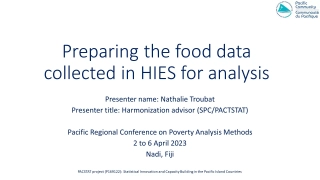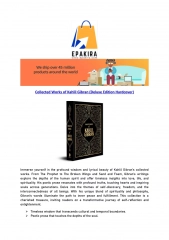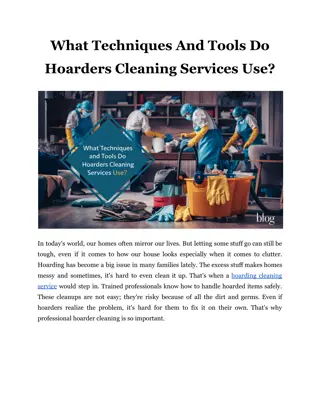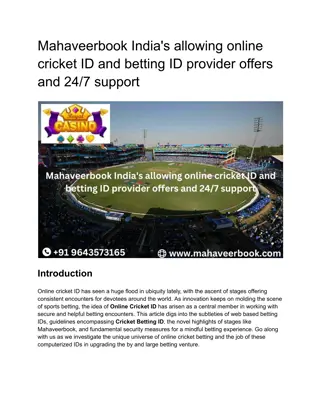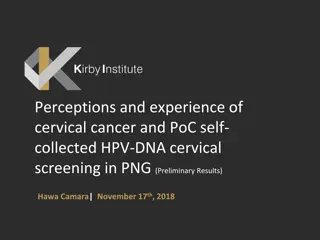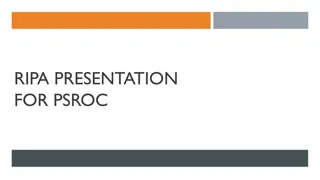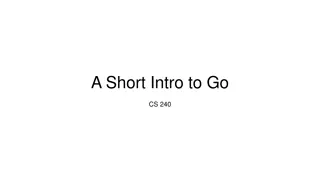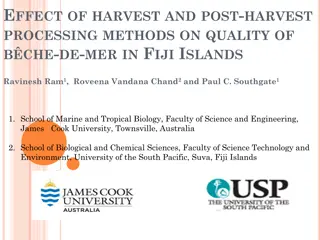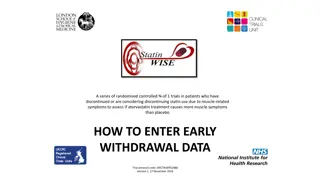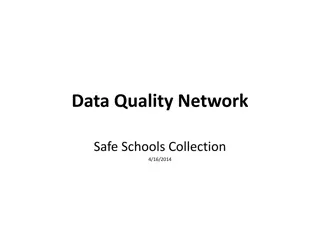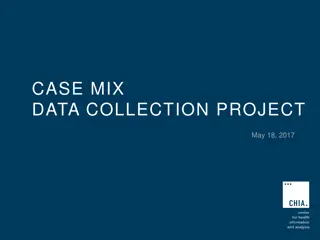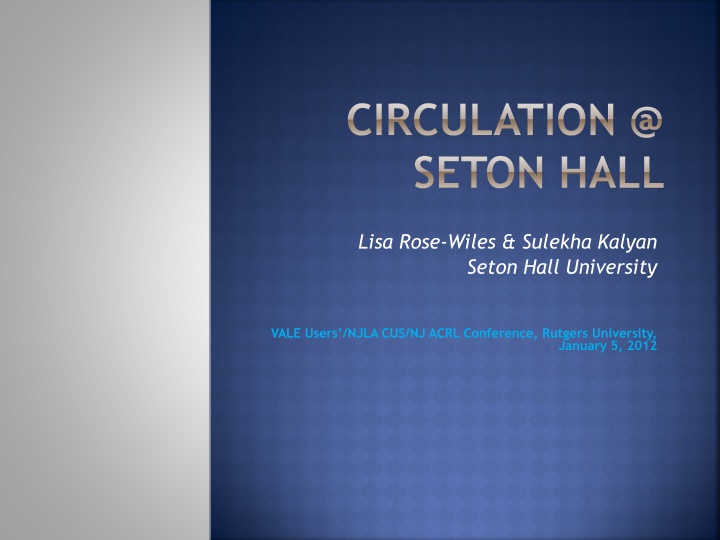
Insights into Seton Hall University Library Collections and Circulation Statistics
Explore the details of Seton Hall University's library collection and circulation trends, including subject areas, publication dates, and circulation data. Discover the distribution of books by subject, publication date ranges, and the proportion of recent publications. Gain insights into the circulation rates of different subject areas and the correlation between publication currency and circulation.
Download Presentation

Please find below an Image/Link to download the presentation.
The content on the website is provided AS IS for your information and personal use only. It may not be sold, licensed, or shared on other websites without obtaining consent from the author. If you encounter any issues during the download, it is possible that the publisher has removed the file from their server.
You are allowed to download the files provided on this website for personal or commercial use, subject to the condition that they are used lawfully. All files are the property of their respective owners.
The content on the website is provided AS IS for your information and personal use only. It may not be sold, licensed, or shared on other websites without obtaining consent from the author.
E N D
Presentation Transcript
CIRCULATION @ SETON HALL Lisa Rose-Wiles & Sulekha Kalyan Seton Hall University VALE Users /NJLA CUS/NJ ACRL Conference, Rutgers University, January 5, 2012
Seton Hall University Private, Catholic University 4,871 undergraduates (88% full time) 3,293 graduates (33% full time). ~800 faculty & staff Other Walsh Library users SHU Alumni; others via ReBL, VALE, PALCI, ILL Extended library hours attract local students Our print book collection. 500,000+ books (excluding journals, archives and special collections) Concerns re space, maintenance, loss or theft, lack of use/declining circulation.
1. SHU books by subject area. Based on OCLC data July 2011, n = 402,112 excluding government documents & other 6% 7% Humanities 7% Social Science Business & Economics Science 15% Health & Medical Sciences 65%
2. Number of books in subject area by publication date range. 80,000 70,000 60,000 Health & Medical Sciences Science 50,000 Business & Economics Social Science 40,000 Humanities 30,000 20,000 10,000 0 pre 1900 1900-1950 1950's 1960's 1970's 1980's 1990's 2000's
3. Proportion of books in major subject areas published since 2000 (n = 74,945) 16.4% 21.0% Humanities Social Science Business & Economics 10.9% Science Health & Medical Sciences 16.3% 11.1%
4. Circulation of SHU books based on OCLC circulation data 2005-9 % books in subject circulated between 2005 and 2009 % books in subject published in 2000's Average checkouts 2005-9 Subject area Arts 34.4% 28.6% 1.73 Sociology 18.4% 27.9% 2.05 History 22.0% 25.0% 1.95 Health & Medical Sciences 16.4% 23.9% 2.13 Political Science 14.8% 23.7% 2.08 Education 17.1% 23.4% 1.96 Anthropology 30.0% 23.0% 1.83 Psychology 12.0% 22.7% 1.90 Law 14.6% 21.5% 1.82 Other 19.8% 21.1% 1.88 Philosophy & Religion 16.0% 20.9% 1.89 Business & Economics 11.1% 18.1% 1.73 Science 10.9% 12.2% 1.66 Literature 11.7% 9.2% 1.68 Average 17.8% 21.5% 1.88
5. Currency vs. circulation (r = 0.614, df =12, p < 0.05) 30% 25% % collection 2000's % circulated 25% 24% 23% 21% 20% 18% 16% 16% 15% 12% 11% 11% 10% 5% 0% Humanities Health & Medical Sciences Social Science Business & Economics Science
6. total checkouts by year and subject 2005-9 (n = 19,208 checkouts) Health & Med science 12.0% Social Science Humanities 10.0% Business Science 8.0% 6.0% 4.0% 2.0% 0.0% checkouts 2005 checkouts 2006 checkouts 2007 checkouts 2008 checkouts 2009
7. Checkouts by patron type, from Voyager data July 2010-11 (n = 38,395 checkouts) 13.6% undergraduate 2.8% grad student 1.1% Faculty 7.6% Adjunct 46.4% 0.9% Admin/Clerical/Other SHU Alumni 5.2% REBL/visitor EZ borrow/ILL 22.4%
8. Science books, OCLC vs. Voyager by date (OCLC = 28,192; Voyager = 28,939 as at July 2011) 7000 OCLC lisascience Voyager Q's 6000 5000 4000 3000 2000 1000 0 pre 1900 1900-1950 1950's 1960's 1970's 1980's 1990's 2000's
9. Science books by date and location (Voyager data, n = 28,939) 7000 6000 Other Curriculum Reference/reserve Main 5000 4000 3000 2000 1000 0 pre 1900 1900-1950 1950's 1960's 1970's 1980's 1990's 2000's
10. Main science collection: circulation vs. publication date (from Voyager data, n = 26,190, average circulated 12%) 40% 36% % collection % circulation 35% 30% 25% 23% 22% 20% 20% 17% 14% 15% 11% 9% 10% 8% 8% 7% 6% 5% 5% 5% 1% 1% 0% pre 1900 1900-1950 1950's 1960's 1970's 1980's 1990's 2000's
11. Average times science Books circulated 2005-10 by location 4.5 4 Main (average 1.8) Curriculum (average 3.5) Other (average 1.3) 3.5 3 2.5 2 1.5 1 0.5 0 pre 1900 1900-1950 1950's 1960's 1970's 1980's 1990's 2000's
12. % of science collection vs. % of science books circulations 2010-11 by subject (from Voyager data, n = 1246 science book checkouts) 35% 30% % circulating books 30% % 2010-11 circulation 25% 21% 19% 20% 19% 17% 17% 16% 15% 13% 11% 10% 9% 9% 10% 7% 5% 1% 0% Math & Computer science Biological Sciences Physics & Astronomy Chemistry Anatomy & Physiology General Science Environmental science
CONCLUSIONS 21.5% of our books were checked out at least once (average twice) in the five years 2005-9. There is variation by subject area, but generally more recent books are more likely to circulate. Our book collection is stronger and more current in the humanities than in other subject areas. Our science book collection is small & outdated: 6.4% of total books, almost 90% >10 years old. Over 36% of recent science books circulated & circulation has not declined in past 5 years. There is not a good fit between subject collections and subject circulation.
RECOMMENDATIONS Judicious weeding is clearly needed some older books are still in demand (or do students disregard publication dates?). We need a better match between our academic programs and collections, especially in the underfunded non-humanities subjects. We need more consultation with faculty, book store, students. Begin a pilot PDA program for e-books with ebrary. 48% of hand-picked e-books were used at least once in the first year. PDA should allow better fit at less cost. Budget, budget, budget! Less money = fewer resources. There is no magic wand.
PROGRESS Inventory and weeding is well underway Better World Books a market/recycler for many unwanted books. We have sent 50+ boxes already. Efforts to reach users ongoing And we are consulting with bookstore re textbooks Pilot PDA has begun with ebrary. We are being conservative (selection not broad profile) but have added 750 books so far. Budget, budget, budget! Driving us to just in time vs. Just in case good, bad, indifferent?
THANK YOU! QUESTIONS? Lisa Rose-Wiles, Science Librarian Sulekha Kalyan, Head of Acquisitions Seton Hall University Libraries Lisa.rose-wiles@shu.edu Sulekha.kalyan@shu.edu

